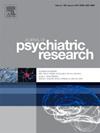自闭特征与对身体的体验和态度:对意大利女性饮食失调患者样本的调查
IF 3.2
2区 医学
Q1 PSYCHIATRY
引用次数: 0
摘要
目的探讨进食障碍女性患者的自闭特征与对身体的体验和态度之间的关系。方法于2023年1月至6月招募DSM-5TR定义的诊断为ed的参与者。采用成人自闭症亚阈值(ADAS)谱和身体态度测试(BAT)探讨自闭症特征的存在和身体态度的改变。结果共纳入44例女性患者。最具代表性的ADAS频谱域是“共情”和“对感官输入的高反应性和低反应性”。正逐步回归分析表明,BAT“负向欣赏体型”因子具有预测作用(R2 = 0.311;调整后的r平方= .277;f = 9.241;p & lt;.0001)通过ADAS频谱“缺乏灵活性”(p = 0.006)和“言语交流”(p = 0.038)域,预测BAT“对自己身体缺乏熟悉”因素(R2 = .587;调整后的r平方= .566;f = 29.092;p & lt;.0001)由ADAS频谱“非语言交流”(p <;.0001)和“感觉输入高反应性和低反应性”(p = .001)域,预测BAT“一般身体不满意”因子(R2 = .290;调整后的r平方= 0.273;f = 17.181;p & lt;.0001)由ADAS频谱“非语言交流”(p <;。)的领域。结论:目前的工作强调,通过ADAS谱评估的几个核心自闭症特征可能预示着身体形象、知识和满意度的改变。阈下自闭症和饮食失调之间的关联支持了EDs可能是自闭症谱系中神经发育障碍的一种可能的精神病理轨迹的假设。本文章由计算机程序翻译,如有差异,请以英文原文为准。
Autistic traits and experience and attitude toward the body: an investigation in a sample of Italian female patients with eating disorders
Objectives
the present study aims to explore possible associations between autistic traits and the experience and attitude toward the body in female patients affected by eating disorders.
Methods
Participants with diagnosis of EDs as defined by the DSM-5TR were recruited between January and June 2023. Adult Autism Subthreshold (ADAS) Spectrum and Body Attitudes Test (BAT) were used to explore the presence of autistic traits and the alteration in body attitude.
Results
44 female patients have been included in the study. The most represented ADAS Spectrum domains were “Empathy” and “Hyper–and hyporeactivity to sensory input”. Forward stepwise regression analysis indicated that BAT “Negative appreciation of body size” factor was predicted (R2 = .311; R-squared adjusted = .277; F = 9.241; p < .0001) by ADAS Spectrum “Inflexibility” (p = .006) and “Verbal communication” (p = .038) domains, BAT “Lack of familiarity with one's own body” factor was predicted (R2 = .587; R-squared adjusted = .566; F = 29.092; p < .0001) by ADAS Spectrum “Non-Verbal communication” (p < .0001) and “Hyper– and hyporeactivity to sensory input” (p = .001) domains, and BAT “General body dissatisfaction” factor was predicted (R2 = .290; R-squared adjusted = .273; F = 17.181; p < .0001) by ADAS Spectrum “Non-Verbal communication” (p < .0001) domain.
Conclusions
the current work highlights that several core autistic traits, as assessed by the ADAS Spectrum, may be predictive of alterations in body image, knowledge, and satisfaction. The observed association between subthreshold autism and eating disorders supports the hypothesis that EDs could be one of the possible psychopathological trajectories of a neurodevelopmental disorder rooted in autism spectrum.
求助全文
通过发布文献求助,成功后即可免费获取论文全文。
去求助
来源期刊

Journal of psychiatric research
医学-精神病学
CiteScore
7.30
自引率
2.10%
发文量
622
审稿时长
130 days
期刊介绍:
Founded in 1961 to report on the latest work in psychiatry and cognate disciplines, the Journal of Psychiatric Research is dedicated to innovative and timely studies of four important areas of research:
(1) clinical studies of all disciplines relating to psychiatric illness, as well as normal human behaviour, including biochemical, physiological, genetic, environmental, social, psychological and epidemiological factors;
(2) basic studies pertaining to psychiatry in such fields as neuropsychopharmacology, neuroendocrinology, electrophysiology, genetics, experimental psychology and epidemiology;
(3) the growing application of clinical laboratory techniques in psychiatry, including imagery and spectroscopy of the brain, molecular biology and computer sciences;
 求助内容:
求助内容: 应助结果提醒方式:
应助结果提醒方式:


